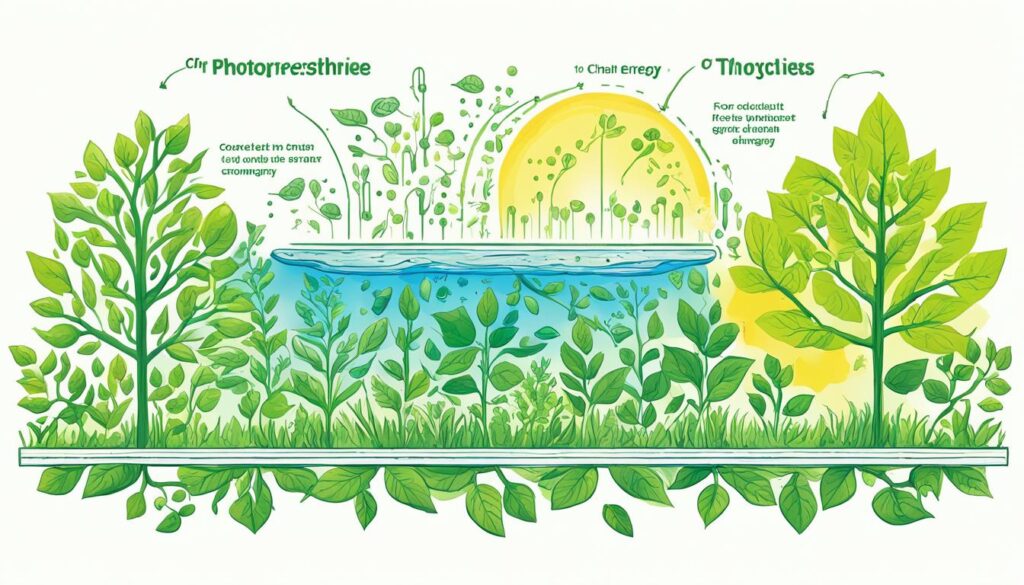Unlock Earth’s Vitality: Net Primary Productivity

Have you ever wondered how the Earth’s ecosystems thrive and maintain a delicate balance? What fuels the growth of plants and the health of our planet? The answer lies in a fascinating concept called Net Primary Productivity (NPP).
Key Takeaways:
- Net Primary Productivity (NPP) is a crucial measure of ecosystem productivity and carbon sequestration.
- Photosynthesis efficiency, plant growth rate, biomass production, and ecological efficiency influence NPP.
- Higher NPP leads to increased carbon sequestration, reducing greenhouse gas emissions.
- Enhancing NPP involves improving photosynthesis efficiency, plant growth rate, and biomass production.
- NPP plays a critical role in sustaining the ecological balance and mitigating climate change.
The Importance of Net Primary Productivity
Net primary productivity (NPP) is a fundamental component of thriving ecosystems. It plays a vital role in carbon sequestration, ensuring the health and functionality of our planet. NPP refers to the amount of carbon dioxide absorbed by plants from the atmosphere and converted into organic matter through the intricate process of photosynthesis.
By optimizing net primary productivity, we can effectively reduce greenhouse gas emissions and combat climate change. When plants exhibit higher NPP, they store more carbon, aiding in the removal of carbon dioxide from the atmosphere and helping to create a sustainable environment for future generations.
The efficiency of photosynthesis is a key determinant of net primary productivity. It determines how proficiently plants convert solar energy into the organic matter that contributes to carbon sequestration. By prioritizing efforts to enhance photosynthesis efficiency, we can maximize the utilization of available resources and energy, ultimately increasing NPP.
Net primary productivity holds immense significance in promoting the sustainability of ecosystems and safeguarding the delicate balance of our planet. By acknowledging the critical role of NPP and striving to improve it, we can make substantial progress in mitigating climate change and preserving our environment for generations to come.

The Role of Net Primary Productivity in Carbon Sequestration
Net primary productivity acts as a catalyst for carbon sequestration, contributing to the reduction of greenhouse gas emissions and the mitigation of climate change impacts. Through the process of photosynthesis, plants absorb carbon dioxide from the atmosphere and convert it into organic matter, effectively trapping the carbon in their biomass.
This carbon sequestration process enables the removal of carbon dioxide from the atmosphere, helping to stabilize and restore the Earth’s climate. Higher levels of net primary productivity translate to increased carbon sequestration, playing a crucial role in achieving carbon neutrality and minimizing the adverse effects of greenhouse gas emissions.
Enhancing ecosystem productivity and optimizing photosynthesis efficiency are key strategies in bolstering carbon sequestration efforts. By prioritizing these endeavors, we can make significant strides towards combating climate change and preserving the ecological integrity of our planet.
Factors Affecting Net Primary Productivity
Net primary productivity (NPP) is influenced by several key factors that contribute to the overall productivity of ecosystems. Understanding and optimizing these factors can enhance NPP, leading to increased carbon sequestration and the sustainable growth of plant life.
The Plant Growth Rate
The plant growth rate is a crucial factor affecting NPP. It refers to the speed at which plants convert carbon dioxide into organic matter through photosynthesis. Higher plant growth rates result in increased net primary productivity. By optimizing conditions such as nutrient availability, light exposure, and temperature, you can accelerate the plant growth rate, boosting NPP and supporting a more productive ecosystem.
Biomass Production
Biomass production, also known as the amount of organic matter produced by plants, is another essential factor influencing NPP. The greater the biomass production, the higher the net primary productivity. This means that by concentrating on strategies that promote healthy plant growth and maximize the production of organic matter, you can contribute to a flourishing ecosystem with enhanced NPP. These strategies may include sustainable agriculture practices, such as efficient irrigation methods and adequate fertilization.
Ecological Efficiency
Ecological efficiency plays a significant role in determining the overall NPP of an ecosystem. It refers to how efficiently energy flows through the ecosystem and is utilized by organisms. Maximizing ecological efficiency can enhance NPP by ensuring that energy is effectively transferred from one trophic level to another. By maintaining a balanced food chain and minimizing energy losses, you can optimize ecological efficiency, leading to greater net primary productivity and a more sustainable ecosystem.
Understanding and optimizing the factors that affect net primary productivity, such as the plant growth rate, biomass production, and ecological efficiency, is essential for promoting a thriving ecosystem. By improving these factors, we can enhance carbon sequestration, support sustainable plant growth, and contribute to a more ecologically efficient world.
Enhancing Net Primary Productivity
To maximize net primary productivity (NPP) and unlock the full potential of our ecosystems, several strategies can be implemented. These approaches aim to optimize factors such as plant growth rate, photosynthesis efficiency, and biomass production. By leveraging these strategies, we can enhance the ability of plants to convert solar energy into organic matter and increase NPP.
Improving Photosynthesis Efficiency
One effective approach is to focus on improving photosynthesis efficiency. Through plant breeding and genetic modification, scientists can enhance the ability of plants to convert sunlight into energy, resulting in higher NPP. By maximizing photosynthesis efficiency, plants can utilize solar energy more effectively, leading to increased biomass production and ecological productivity.
Optimizing Plant Growth Rates
Another strategy for enhancing NPP is to optimize plant growth rates. This can be achieved through the use of fertilizers, irrigation, and other agricultural techniques. By providing plants with the necessary nutrients and resources for faster growth, we can accelerate carbon dioxide conversion, leading to higher NPP. The careful management of plant growth rates can significantly contribute to increasing overall ecosystem productivity.
Increasing Biomass Production
Efforts to increase biomass production through reforestation and afforestation can also have a significant impact on NPP. These activities involve the planting of trees and vegetation in areas that have been deforested or lack plant cover. By restoring and expanding green spaces, we can boost carbon sequestration, enhance photosynthesis, and increase NPP. The resulting increase in biomass production contributes to a healthier and more productive ecosystem.
By implementing these strategies, we can harness the power of net primary productivity to drive sustainable growth and ecological balance. Enhancing photosynthesis efficiency, optimizing plant growth rates, and increasing biomass production all play crucial roles in ensuring that our ecosystems thrive and continue to sequester carbon effectively.

It is essential to find innovative ways to maximize net primary productivity and leverage its potential for the betterment of our planet.
The Role of Net Primary Productivity in Carbon Sequestration
Net primary productivity (NPP) is a key driver of carbon sequestration, contributing to the reduction of greenhouse gas emissions and the mitigation of climate change. By understanding the crucial role of NPP in ecosystem productivity, we can implement strategies to enhance carbon sequestration efforts and create a more sustainable future.
Through the process of photosynthesis, plants play a vital role in carbon sequestration. They absorb carbon dioxide from the atmosphere and convert it into organic matter, capturing the carbon within their biomass. This natural process helps remove carbon dioxide from the atmosphere and mitigate its impact on global warming.
Higher levels of net primary productivity lead to increased carbon sequestration, making it an essential factor in achieving carbon neutrality. By enhancing ecosystem productivity and photosynthesis efficiency, we can optimize carbon sequestration efforts and promote a healthier environment.
To illustrate the significance of net primary productivity in carbon sequestration, consider the following table:
| Low Net Primary Productivity | High Net Primary Productivity | |
|---|---|---|
| Carbon Sequestration | Limited | Significant |
| Ecosystem Health | Compromised | Thriving |
| Climate Change Mitigation | Ineffective | Effective |
As depicted in the table, higher levels of net primary productivity result in increased carbon sequestration, indicative of a thriving ecosystem and more effective climate change mitigation. By prioritizing efforts to enhance net primary productivity, we can accelerate the removal of carbon dioxide from the atmosphere and create a more sustainable future.

Conclusion
Net primary productivity (NPP) is a vital element in maintaining the ecological balance of our planet. It plays a significant role in carbon sequestration, thereby helping to combat climate change by removing carbon dioxide from the atmosphere. By optimizing factors such as photosynthesis efficiency, plant growth rate, and biomass production, we can enhance NPP and contribute to a thriving future for our planet.
Higher levels of net primary productivity lead to increased carbon sequestration, making it essential for achieving carbon neutrality and reducing greenhouse gas emissions. By focusing on strategies that enhance NPP, such as improving the efficiency of photosynthesis and increasing biomass production, we can make a significant impact on mitigating climate change.
Enhancing net primary productivity is crucial for sustaining ecosystem productivity and fostering a more sustainable and resilient environment. By ensuring that plants efficiently convert solar energy into organic matter and optimizing the growth rate of plants, we can maximize NPP and support the health and functionality of ecosystems.






